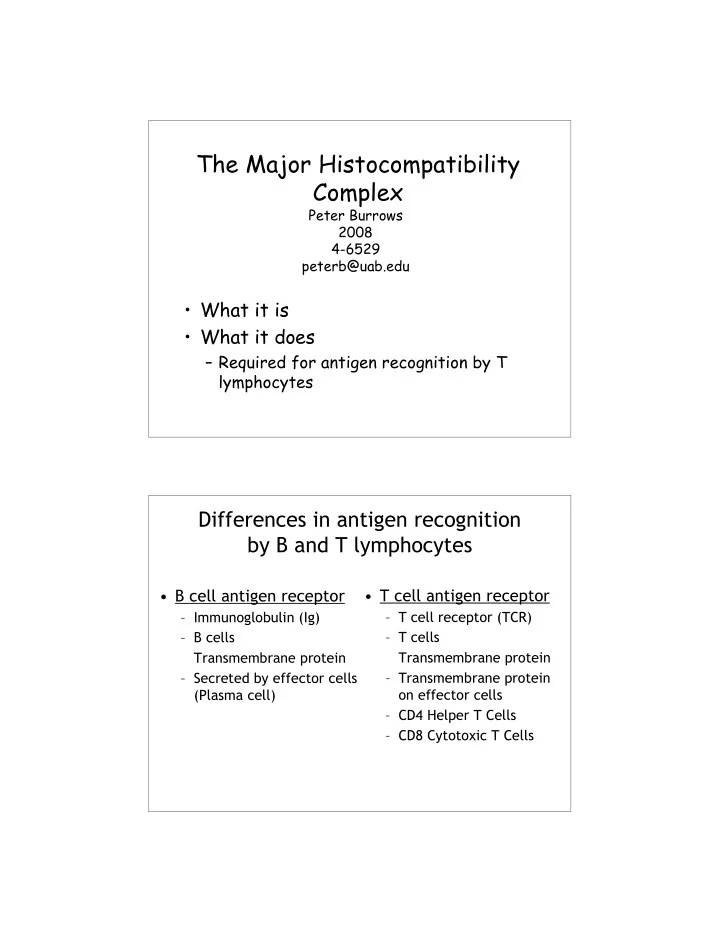

The Major Histocompatibility Complex Peter Burrows 2008 4-6529 peterb@uab.edu • What it is • What it does – Required for antigen recognition by T lymphocytes Differences in antigen recognition by B and T lymphocytes • T cell antigen receptor • B cell antigen receptor – Immunoglobulin (Ig) – T cell receptor (TCR) – B cells – T cells Transmembrane protein Transmembrane protein – Secreted by effector cells – Transmembrane protein (Plasma cell) on effector cells – CD4 Helper T Cells – CD8 Cytotoxic T Cells
Review of Differences in T and B Cells • B cells – Recognize native protein antigens in solution or on cell surfaces – Secreted antibody is effector molecule – Antibodies can operate at a distance Antigen-antibody Interaction Heavy Chain Lysozyme Antigenic Determinant Light Chain Epitope
Review of Differences in T and B Cells • B cells • T cells – Recognize native – Recognize peptides from protein antigens in degraded antigens solution or on cell – Peptides are displayed on surfaces cell surfaces in association – Secreted antibody is with specialized proteins effector molecule (MHC) – Antibodies can operate at a distance Proteases TCR #1 TCR #2 Lysozyme
T cells recognize processed (degraded) protein antigens TCR 2 Why? Review of Differences in T and B Cells • B cells • T cells – Recognize native – Recognize peptides from protein antigens in degraded antigens solution or on cell – Peptides are displayed on surfaces cell surfaces in association – Secreted antibody is with specialized proteins effector molecule (MHC) – Antibodies can – Antigen-specific T cell operate at a functions require direct cell ⇔ cell interactions distance
Major Histocompatibility Complex • Discovered using inbred strains of mice and examining tumor immunity • Were really studying transplantation immunology – histocompatibility antigens • MHC is the major histocompatibility antigen that needs to be matched for organ transplantation • A complex of linked genes encodes the MHC proteins • Normal function of MHC is to display peptide antigens (self AND non-self) to T cells MHC • MHC I and MHC II – Genes – Structure – Polymorphisms • MHC and T cell responses
MHC Class I • Expressed by all nucleated cells • Presents peptide to CD8 T cells – Cytotoxic “killer” cells – Kill virus infected cells MHC Class II • Expressed by specialized antigen presenting cells (APC) – Dendritic cells – B cells – Macrophages • Presents peptide to CD4 T cells • “Helper” T cells – Help B cells proliferate, differentiate, isotype switch – Help activate macrophages to kill intracellular pathogens
Helper CD4 T cells MHC Class II Class I
Class I and Class II MHC Molecules • Membrane bound glycoproteins • Structurally very similar • Both have 4 domains – 2 membrane proximal domains – 2 membrane distal domains that form a peptide binding cleft 3-D Structure of Human Class I HLA Molecule
Peptides in the MHC groove
B Cell Class I Help! Class II Self peptide Foreign peptide BCR B B Cell Cell TCR Class I Class II Self peptide Foreign peptide
MHC Polymorphisms • Allelic variations in MHC genes • Concentrated in the peptide binding regions of Class I and Class II
MHC Polymorphisms The human MHC gene complex HLA – human leukocyte antigen
MHC Polymorphisms • Allelic variations in MHC genes • Concentrated in the peptide binding regions of Class I and Class II • Population level • Individual will inherit 9 maternal and 9 paternal MHC genes No gene rearrangements • All are expressed with the MHC! Consequences of MHC Polymorphism • Organ and tissue transplants are difficult • Polymorphic residues change the peptide binding specificity of the MHC • If all MHC were identical, pathogens might avoid immune detection by mutation to prevent MHC binding
Why have two antigen recognition systems? Tc Tc
Recommend
More recommend